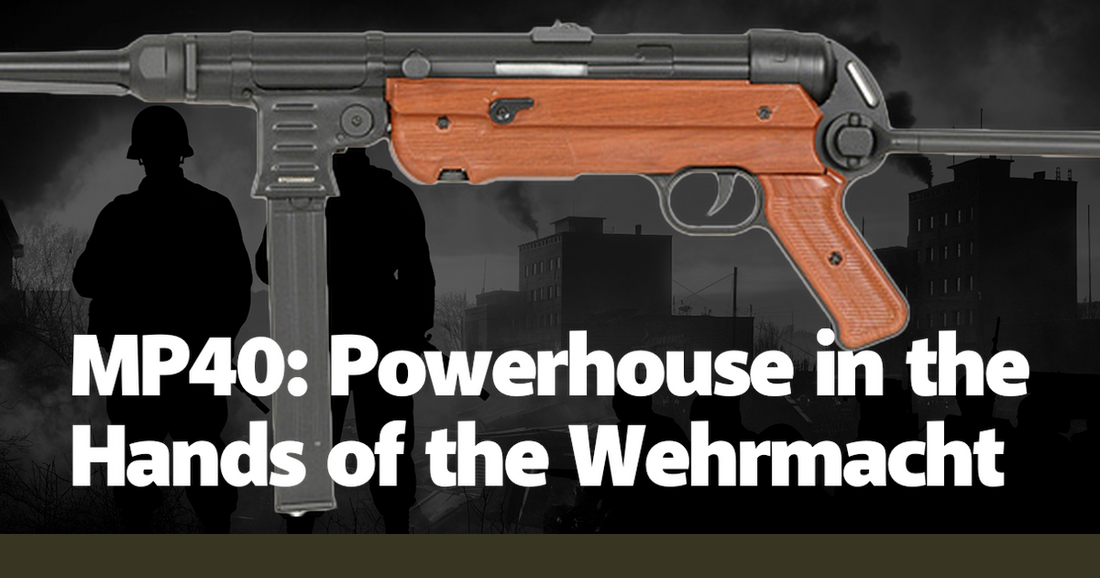The MP40, often dubbed the "Schmeisser" after weapons designer Hugo Schmeisser, despite him having no direct involvement in its creation, stands as an iconic symbol of the Wehrmacht's infantry firepower during World War II. Developed in 1938 and entering service in 1940, the MP40 was a submachine gun that combined simplicity, efficiency, and deadly effectiveness. Its design was a response to the need for a reliable, mass-producible weapon that could serve the German infantry in a variety of combat scenarios. The MP40's compact size and relatively lightweight made it an ideal choice for paratroopers, tank crews, and other specialized units who required a potent yet manageable firearm.
The MP40 featured a folding stock and was chambered for the 9x19mm Parabellum cartridge, which was already a standard issue for German pistols, thus ensuring logistical consistency. With a rate of fire of around 500-550 rounds per minute, it provided a balance between controllability and firepower, making it highly effective in close-quarter battles. The weapon's blowback-operated, open-bolt design was both robust and easy to produce, a critical factor during the high-demand war years. The use of stamped steel parts instead of machined components further simplified production and reduced costs, allowing the Germans to equip their troops extensively.
One of the most compelling aspects of the MP40's service history is its widespread use across various theaters of war. From the icy fronts of the Soviet Union to the scorching deserts of North Africa, the MP40 proved its versatility and reliability. German soldiers, often outnumbered but rarely outgunned, relied on the MP40 to level the playing field. Anecdotes from the Eastern Front recount how the MP40's compact design allowed soldiers to maneuver through trenches and urban rubble with ease, delivering devastating bursts of fire that could turn the tide of skirmishes.
The MP40's influence extended beyond the German military. Captured MP40s were highly prized by Allied forces, who often used them when their own supplies were low. The weapon's ergonomic design and ease of use made it a favorite among resistance fighters and partisans across occupied Europe. Stories of French, Yugoslav, and Soviet partisans wielding captured MP40s against their occupiers add a layer of irony to the weapon's legacy. These fighters appreciated the same qualities that German soldiers did: reliability, ease of maintenance, and effective firepower.
Despite its many advantages, the MP40 was not without its flaws. Its open-bolt design, while simplifying the mechanism, also made it susceptible to dirt and debris, which could cause malfunctions. The 32-round magazine, while generous, was prone to feeding issues if not handled carefully. Furthermore, the weapon's effective range was limited compared to rifles, which meant that it was primarily a tool for close-quarters combat. Nonetheless, these drawbacks were often overshadowed by the MP40's overall performance and the tactical advantages it provided.
The legacy of the MP40 is also reflected in its influence on post-war submachine gun designs. The simplicity and effectiveness of the MP40's design principles can be seen in later weapons such as the Israeli Uzi and the American M3 Grease Gun. These weapons adopted the MP40's use of stamped metal parts and straightforward operating mechanisms, proving that the German design had set a new standard for submachine guns. The MP40's impact on small arms development is a testament to its innovative engineering and practical effectiveness.
In the hands of the Wehrmacht, the MP40 was more than just a weapon; it was a force multiplier that allowed German infantry to execute their Blitzkrieg tactics with lethal efficiency. The ability to deliver rapid, accurate fire in close quarters made it an indispensable tool during the rapid advances and urban warfare that characterized much of the conflict. The psychological impact of facing an enemy equipped with such a formidable weapon cannot be underestimated, contributing to the MP40's fearsome reputation.
Ultimately, the MP40's place in military history is secured by its combination of innovative design, practical effectiveness, and widespread use. It remains a symbol of German engineering prowess and a reminder of the brutal efficiency of World War II combat. As historians and enthusiasts continue to study and collect these weapons, the MP40's story serves as a poignant example of how technology and warfare are inextricably linked, each shaping the other in the relentless march of history.

